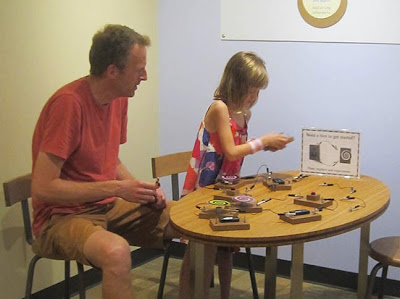Most visitors know Providence Children’s Museums as a collection of experiences in which children and families learn through play and active exploration. One of the defining features of our exhibits is that they are rich in discoveries and stimulating for the senses. We incorporate unusual and ordinary objects to make learning tangible, and are deeply committed to surrounding children with beautiful learning environments.
One way we do this is by sharing the Museum’s collection of childlife objects, which includes tin toys, penguin figurines and a wonderful grouping of marionettes created by Betty Heustis (1901-1983). We also love sharing other people’s collections. This spring, children and families investigated intricate metal miniatures handcrafted by Cambridge, MA artist Abraham Megerdichian (1923-1983) and shared by his family, and colorful Chinese and Indonesian shadow puppets from the collection of Hilary Salmons, executive director of Providence After School Alliance.
Collections are fascinating – they tell stories about the objects themselves and the individuals and institutions that collect them. At the Museum, they provide tangible, powerful ways for children and families to engage in quiet moments of observation and reflection. And for individuals, collecting offers opportunities to build and share pieces of themselves.
From a very young age, children form attachments to things – favorite blankets or stuffed animals – and as they develop, they begin collecting objects that they enjoy in other ways, like rocks, stickers or postcards. Collecting is empowering. It allows kids to make their own choices about what to collect and how to display it. Their collections are their creations, which say something special about their identity and their world at a particular moment in time.
Museum staff shared some of their favorite childhood (and grown-up) collections:
“When I was maybe 10 to 12, I used to collect business cards from stores. Maybe I was inspired by the Laura Ingalls Wilder books – in one of them having a “calling card” was a very big deal.”
– Cathy, Education Director“My dad traveled a lot for work when I was growing up and he would always bring me a snow globe from wherever he was visiting. I didn’t really have any special attachment to the globes themselves, but I loved he was thinking of me while he was away.”
– Turenne, Volunteer & AmeriCorps Coordinator“As a child I was completely entranced by “The Wizard of Oz” and collected everything related to the movie. I had a set of miniature dolls, posters, books, costumes and even a marionette puppet of Dorothy.”
– Corrie, Membership & Marketing Coordinator“In high school, I collected psychedelic polyester shirts from the 1970s. I think I had over 40 all together, and yes, I did wear them regularly.”
– Suzy, Research & Evaluation Specialist“My 7-year old daughter and I collect chickens in a variety of forms (ceramic, wire, cloth). This started with a friend who made some artful chickens and gave them to us, and from there we have started buying chickens whenever we see them. They now roost in our home.”
– Jessica, Exhibit DeveloperWhat do you and your kids like to collect? There’s almost no limit to what’s possible!





